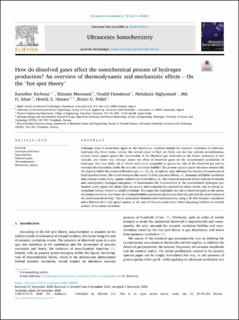| dc.contributor.author | Kerboua, Kaouther | |
| dc.contributor.author | Merouani, Slimane | |
| dc.contributor.author | Hamdaoui, Oualid | |
| dc.contributor.author | Alghyamah, Abdulaziz | |
| dc.contributor.author | Islam, Md Hujjatul | |
| dc.contributor.author | Hansen, Henrik Erring | |
| dc.contributor.author | Pollet, Bruno | |
| dc.date.accessioned | 2023-01-12T12:57:02Z | |
| dc.date.available | 2023-01-12T12:57:02Z | |
| dc.date.created | 2021-01-19T07:56:00Z | |
| dc.date.issued | 2020 | |
| dc.identifier.citation | Ultrasonics sonochemistry. 2020, 72 . | en_US |
| dc.identifier.issn | 1350-4177 | |
| dc.identifier.uri | https://hdl.handle.net/11250/3043070 | |
| dc.description.abstract | Although most of researchers agree on the elementary reactions behind the sonolytic formation of molecular hydrogen (H2) from water, namely the radical attack of H2O and H2O2 and the free radicals recombination, several recent papers ignore the intervention of the dissolved gas molecules in the kinetic pathways of free radicals, and hence may wrongly assess the effect of dissolved gases on the sonochemical production of hydrogen. One may fairly ask to which extent is it acceptable to ignore the role of the dissolved gas and its eventual decomposition inside the acoustic cavitation bubble? The present opinion paper discusses numerically the ways in which the nature of dissolved gas, i.e., N2, O2, Ar and air, may influence the kinetics of sonochemical hydrogen formation. The model evaluates the extent of direct physical effects, i.e., dynamics of bubble oscillation and collapse events if any, against indirect chemical effects, i.e., the chemical reactions of free radicals formation and consequently hydrogen emergence, it demonstrates the improvement in the sonochemical hydrogen production under argon and sheds light on several misinterpretations reported in earlier works, due to wrong assumptions mainly related to initial conditions. The paper also highlights the role of dissolved gases in the nature of created cavitation and hence the eventual bubble population phenomena that may prevent the achievement of the sonochemical activity. This is particularly demonstrated experimentally using a 20 kHz Sinaptec transducer and a Photron SA 5 high speed camera, in the case of CO2-saturated water where degassing bubbles are formed instead of transient cavitation. | en_US |
| dc.language.iso | eng | en_US |
| dc.publisher | Elsevier | en_US |
| dc.rights | Attribution-NonCommercial-NoDerivatives 4.0 Internasjonal | * |
| dc.rights.uri | http://creativecommons.org/licenses/by-nc-nd/4.0/deed.no | * |
| dc.title | How do dissolved gases affect the sonochemical process of hydrogen production? An overview of thermodynamic and mechanistic effects – On the “hot spot theory” | en_US |
| dc.title.alternative | How do dissolved gases affect the sonochemical process of hydrogen production? An overview of thermodynamic and mechanistic effects – On the “hot spot theory” | en_US |
| dc.type | Peer reviewed | en_US |
| dc.type | Journal article | en_US |
| dc.description.version | publishedVersion | en_US |
| dc.source.pagenumber | 10 | en_US |
| dc.source.volume | 72 | en_US |
| dc.source.journal | Ultrasonics sonochemistry | en_US |
| dc.identifier.doi | 10.1016/j.ultsonch.2020.105422 | |
| dc.identifier.cristin | 1873850 | |
| cristin.ispublished | true | |
| cristin.fulltext | original | |
| cristin.qualitycode | 1 | |

